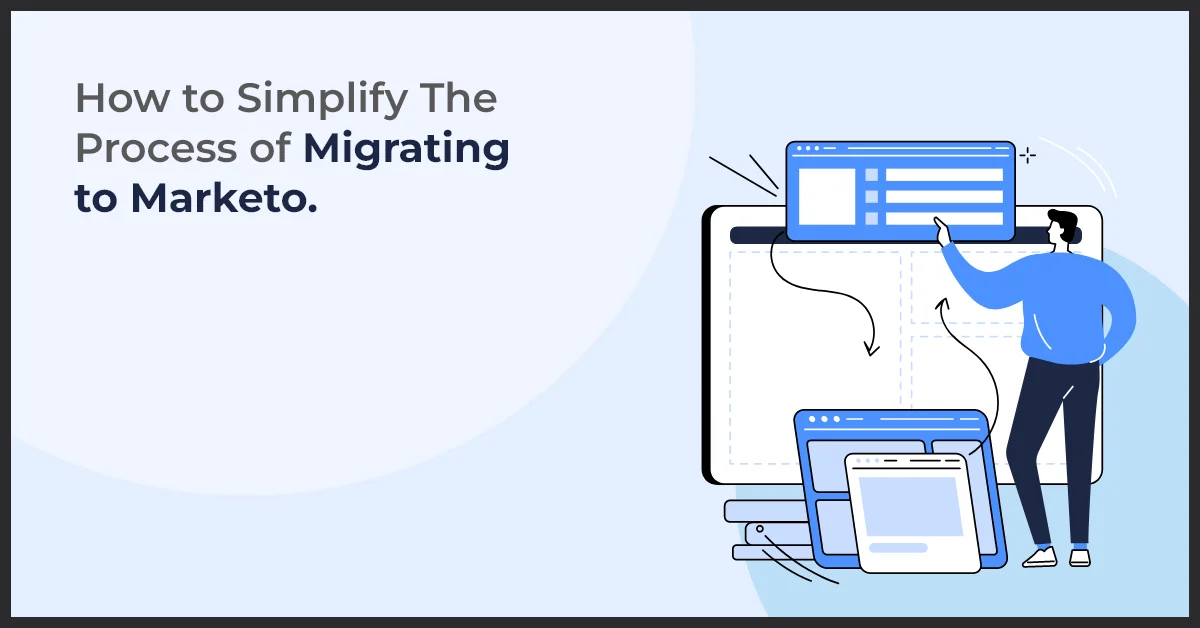How to Easily Migrate to Marketo for Better Results

Published on: January 14, 2022
Updated on: March 07, 2025
2235 Views
- Marketo
6 min read
Is migrating to Marketo the right move for your business? If your current marketing platform lacks the features needed for a successful marketing campaign, then Marketo migration makes perfect sense. We offer key insights into how to streamline your transition to this leading B2B and B2C marketing automation platform.
Marketo—the leading B2B and B2C marketing automation platform—offers a wide range of features and functionalities that help automate and evaluate your marketing engagement and workflows; target highly qualified leads and generate increased lead-to-revenue opportunities; and ensure your business achieves scalability, reliability, and competitive edge.
However, migrating to Marketo can be a tricky affair, requiring lots of planning, strategy, and afterthought. As every business and its requirements are unique, it’s imperative to select the right approach customized and central to your scope.
So, let’s discuss the preparation steps and approaches you can use to simplify the process of migrating to Marketo:
What is Marketo migration and why should you consider it?
Migrating to Marketo offers a powerful solution for businesses struggling with limited marketing automation capabilities. If your current marketing platform lacks the features you need to run successful campaigns, migrating to Marketo provides access to advanced lead generation, workflow automation, and engagement tracking tools. The Marketo migration process transforms how you connect with prospects and measure campaign effectiveness, making it an ideal choice for B2B and B2C organizations seeking scalable marketing solutions. This comprehensive guide will walk you through the essential steps of migrating to Marketo while minimizing disruption to your existing marketing operations.
Prerequisites to Marketo Migration
Before selecting the right migration tools, you have to understand your marketing goals, migration requirements, and other business implications.
Here’s how you should begin:
1. Align your teams
Migration is a complicated and time-consuming process. It’s important you involve all your workforce from sales, marketing, and IT teams to ensure the migration process remains hassle-free and easy. It also makes sense to appoint a supervisor to oversee the entire migration process thoroughly.
2. Clearly define your objectives
It’s pivotal to carefully think about your migration goals and what you want to accomplish with Marketo integration. You have to audit your marketing requirements and analyze what Marketo can add to your current capabilities. This will help you define your objectives and formulate the right migration strategy.
3. Proactively plan your activities
Based on your requirements and objectives, you have to create a timeline, allocate a budget, define activities, and assign roles to your marketing team. Before you start your migration process, you can use the time to assess your business initiatives and practices to understand what’s working and what’s not.
4. Organize your assets
Before beginning the actual task of migration, you need to carefully select the databases and files you want to migrate to the Marketo platform. By cleaning up your databases of junk, you can prioritize only the data you want and speed up the migration process.
Once you have migrated to Marketo, you can follow certain best practices to get acclimated to the new platform and minimize any roadblocks.
Gearing Up After Migrating to Marketo
Migrating from your existing marketing platform to Marketo is half the journey since acclimatizing to the new automation platform can be a daunting task if you are unaware of where and how to start.
Here’s the checklist you can follow after migrating to Marketo that can help you adapt quickly.
1. Assigning users
The first step after Marketo implementation is signing in, creating users, and assigning roles to each user accordingly. It also includes configuring the Marketo Support to add authorized contacts.
2. Setting up landing pages
Change the subdomain URL of your landing pages to allow your marketing campaigns to run on Marketo. You also need to select a Canonical Name (CNAME) for your landing pages. After that, configure the DNS Record for each CNAME.
3. Setting up emails
Similar to the landing pages, select the email CNAME and the DNS record for each CNAME to ensure smooth email deliverability. You also need to check if the Marketo is listed in the whitelist section. Once done, configure the email CNAME in Marketo.
Read More: How To Bridge The Gap Between Salesforce And Marketo To Data
4. Syncing CRM platform
Syncing your CRM platform to Marketo ensures all your contacts are accessible on the automation platform. To ensure it happens without any loss of data, it’s advisable to seek professional assistance to embed the tracking code on your business website.
5. Validating assets
To ensure your campaigns run smoothly on the Marketo platform, make sure you check and validate every contact, link, and other asset linked to the campaigns. If every asset is validated accurately, you can rest assured your campaigns are working smoothly on Marketo.
6. Starting with simple campaigns
After migrating to Marketo, you can start with easier campaigns first, to get hold of the things. For instance, you can choose a single email campaign and evaluate its performance before using any multichannel campaign. This will help you understand the platform properly and build enough experience to use complex programs later on.
7. Getting professional help
After migrating to Marketo, you may need professional assistance to understand the features and make the most out of your marketing campaigns. Plus, professional guidance will also help you troubleshoot issues faster and ensure seamless operability.
Key Takeaways
- Strategic Planning is Essential for Migration – Migrating to Marketo requires thorough planning, including aligning teams, defining objectives, and organizing assets to ensure a smooth transition.
- Collaboration Across Departments is Crucial – Successful migration depends on the involvement of sales, marketing, and IT teams, ensuring seamless execution and minimizing disruptions.
- Post-Migration Setup is Critical for Success – After migrating, businesses must configure landing pages, emails, CRM sync, and validate assets to maximize the effectiveness of Marketo.
- Starting with Simple Campaigns Helps in Adaptation – New users should begin with basic campaigns to familiarize themselves with the platform before implementing complex marketing strategies.
- Professional Assistance Can Optimize Marketo Implementation – Seeking expert guidance can help businesses fully utilize Marketo’s features, troubleshoot issues, and improve overall marketing efficiency.
Wrapping Up
Marketo integration offers state-of-the-art features to scale and increase productivity. It has features that help you connect with large teams, collaborate, and coordinate through an intuitive interface.
Marketo has unparalleled functionality and a rich set of features that set it apart from the rest of its competitors. Connect with our team of experts to know more about the Marketo platform and how we can assist you with Marketo migration and implementation; write to us at info@growthnatives.com.



